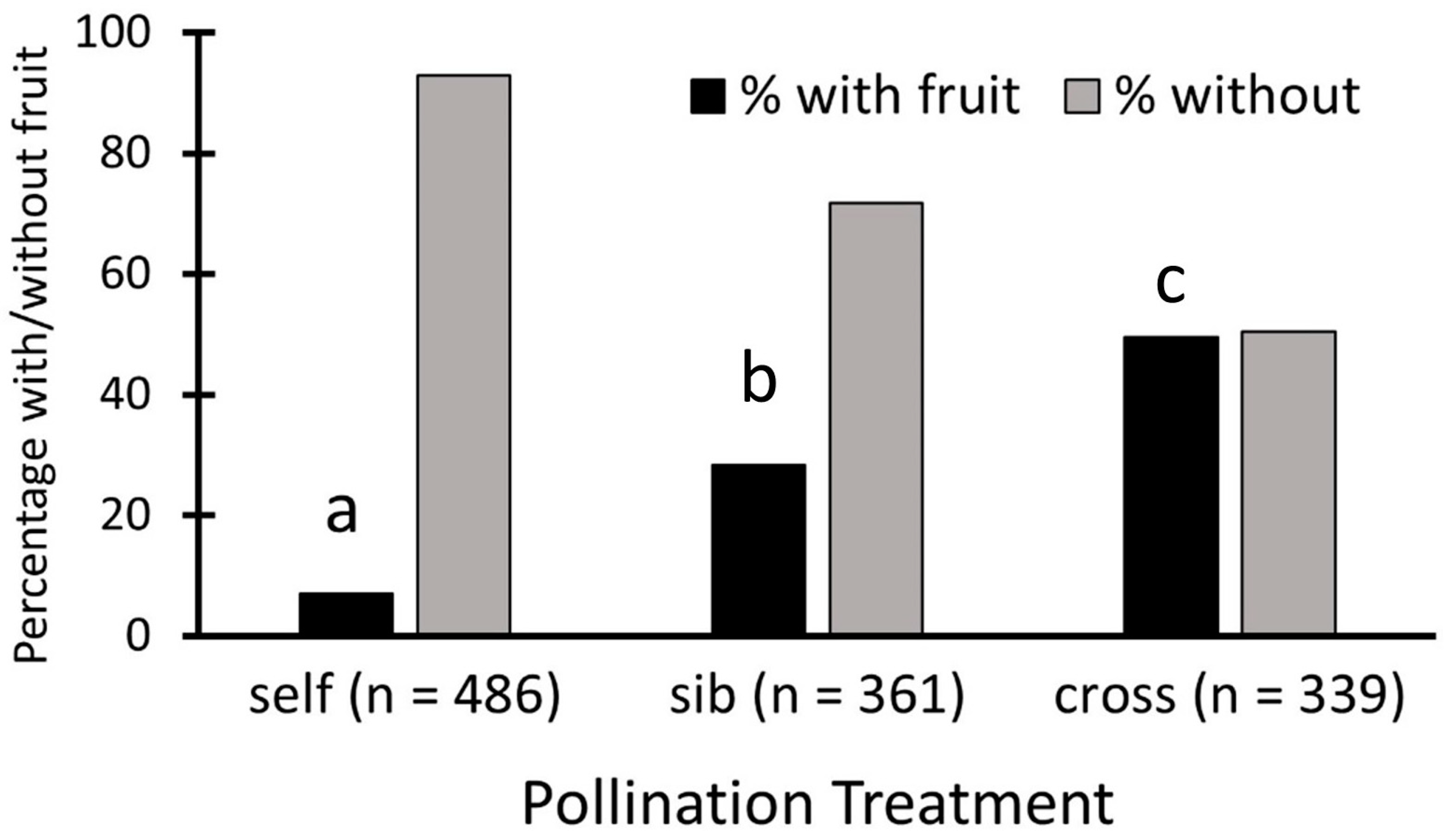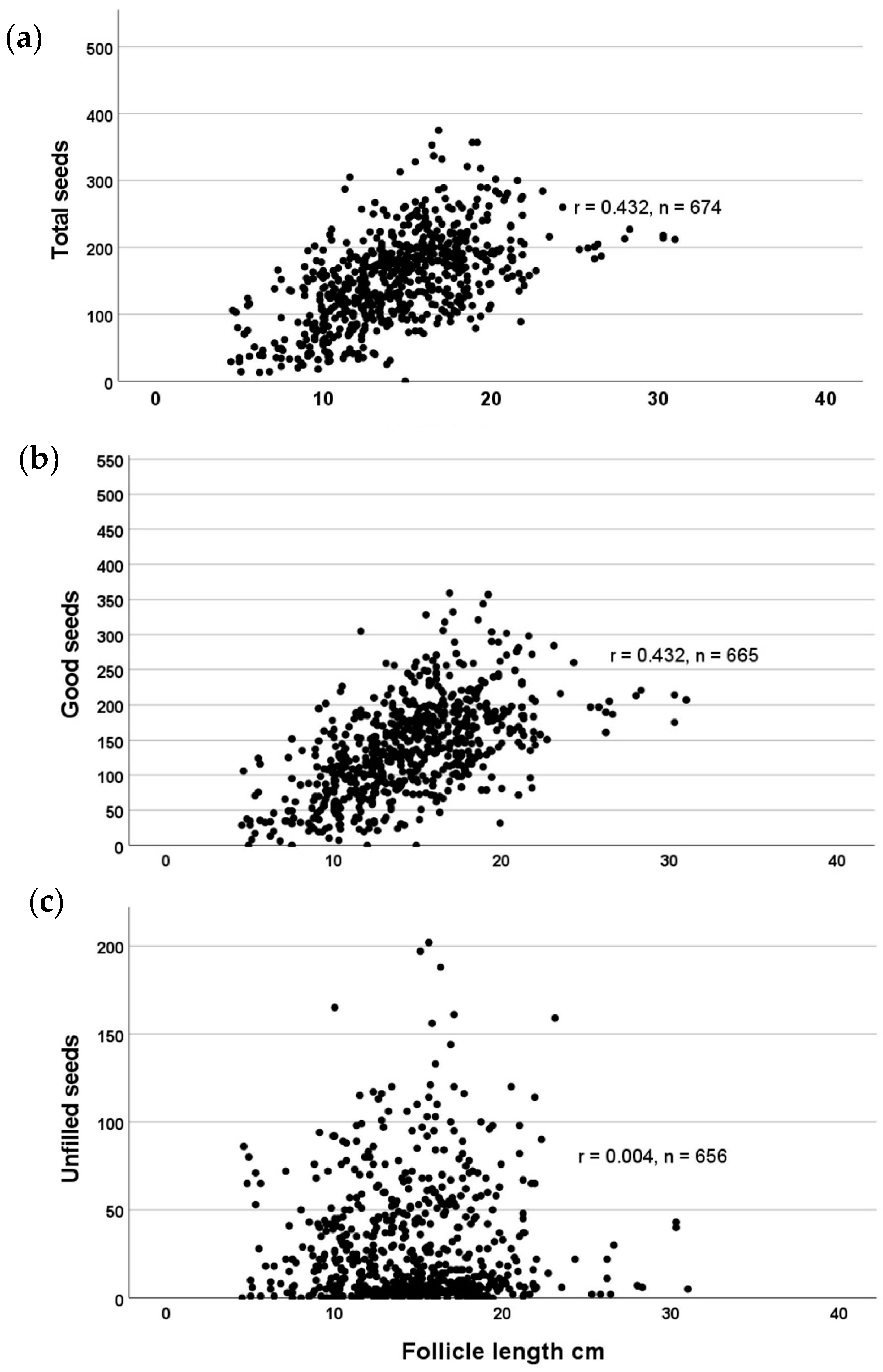Self-Incompatibility in Devil’s Potato (Echites umbellatus Jacq., Apocynaceae) May Explain Why Few Flowers Set Fruit
Abstract
Simple Summary
Abstract
1. Introduction
2. Materials and Methods
2.1. Study Organism
2.2. Experimental Procedure
2.3. Data Analysis
3. Results
4. Discussion
5. Conclusions
Author Contributions
Funding
Institutional Review Board Statement
Data Availability Statement
Acknowledgments
Conflicts of Interest
References
- Johnson, S.D.; Neal, P.R.; Peter, C.I.; Edwards, T.J. Fruiting failure and limited recruitment in remnant populations of the hawkmoth-pollinated tree Oxyanthus pyriformis subsp. pyriformis (Rubiaceae). Biol. Conserv. 2004, 120, 31–39. [Google Scholar] [CrossRef]
- Cruz-Neto, O.; Machado, I.C.; Duarte, J.A.; Lopes, A.V. Synchronous phenology of hawkmoths (Sphingidae) and Inga species (Fabaceae–Mimosoideae): Implications for the restoration of the Atlantic forest of northeastern Brazil. Biodivers Conserv. 2011, 20, 751–765. [Google Scholar] [CrossRef]
- Kearns, C.A.; Inouye, D.W. Pollinators, flowering plants, and conservation biology-much remains to be learned about pollinators and plants. Bioscience 1997, 473984, 297–307. [Google Scholar] [CrossRef]
- Kearns, C.A.; Inouye, D.W.; Waser, N.M. Endangered mutualisms; the conservation of plant-pollinator interactions. Annu. Rev. Ecol. Syst. 1998, 29, 83–112. [Google Scholar] [CrossRef]
- Wagner, D.L.; Grames, E.M.; Forister, M.L.; Berenbaum, M.R.; Stopak, D. Insect decline in the Anthropocene: Death by a thousand cuts. Proc. Natl. Acad. Sci. USA 2021, 118, e2023989118. [Google Scholar] [CrossRef] [PubMed]
- Aizen, M.A.; Garibaldi, L.A.; Harder, L.D. Myth and reality of a global crisis for agricultural pollination. Ecol. Austral-Aniversario 2022, 32, 698–715. [Google Scholar] [CrossRef]
- Dicks, L.V.; Breeze, T.D.; Ngo, H.T.; Senapathi, D.; An, J.; Aizen, M.A.; Basu, P.; Buchori, D.; Galetto, L.; Garibaldi, L.A.; et al. A global-scale expert assessment of drivers and risks associated with pollinator decline. Nat. Ecol. Evol. 2021, 5, 1453–1461. [Google Scholar] [CrossRef] [PubMed]
- Aizen, M.A.; Ashworth, L.; Galetto, L. Reproductive success in fragmented habitats: Do compatibility systems and pollination specialization matter? J. Veg. Sci. 2002, 13, 885–892. [Google Scholar] [CrossRef]
- Rusterholz, H.; Baur, B. Delayed response in a plant–pollinator system to experimental grassland fragmentation. Oecologia 2010, 163, 141–152. [Google Scholar] [CrossRef]
- Brudvig, L.A.; Damschen, E.I.; Tewksbury, J.J. The influence of habitat fragmentation on multiple plant-animal interactions and plant reproduction. Ecology 2015, 96, 2669–2678. [Google Scholar] [CrossRef]
- Ashman, T.-L.; Knight, T.M.; Steets, J.A.; Amarasekare, P.; Burd, M.; Campbell, D.R.; Dudash, M.R.; Johnston, M.W.; Mazer, S.J.; Mitchell, R.J.; et al. Pollen limitation of plant reproduction: Ecological and evolutionary causes and consequences. Ecology 2004, 85, 2408–2421. [Google Scholar] [CrossRef]
- Minno, M.; Darrow, H. Pseudosphinx tetrio (L.) (Lepidoptera: Sphingidae) in the Florida Keys. News Lepid. Soc. 1995, 37, 5–6. [Google Scholar]
- Janzen, D.H. Two potential coral snake mimics in a tropical deciduous forest. Biotropica 1980, 12, 77–78. [Google Scholar] [CrossRef]
- Livshultz, T.; Mead, J.V.; Goyder, D.J.; Brannin, M. Climate niches of milkweeds with plesiomorphic traits (Secamonoideae; Apocynaceae) and the milkweed sister group link ancient African climates and floral evolution. Am. J. Bot. 2011, 98, 1966–1977. [Google Scholar] [CrossRef] [PubMed]
- Harder, L.D.; Johnson, S.D. Function and Evolution of Aggregated Pollen in Angiosperms. Int. J. Plant Sci. 2008, 169, 59–78. [Google Scholar] [CrossRef]
- Livshultz, T.; Middleton, D.J.; Endress, M.E.; Williams, J.K. Phylogeny of Apocynoideae and the APSA clade (Apocynaceae s.l.) 1. Ann. Mo. Bot. Gard. 2007, 94, 324–359. [Google Scholar] [CrossRef]
- Fishbein, M.; Livshultz, T.; Straub, S.C.K.; Simões, A.O.; Boutte, J.; McDonnell, A.; Foote, A. Evolution on the backbone: Apocynaceae phylogenomics and new perspectives on growth forms, flowers, and fruits. Am. J. Bot. 2018, 105, 495–513. [Google Scholar] [CrossRef] [PubMed]
- Koptur, S.; Livshultz, T.; Ionta, G.; Tan, C. Contrasting Pollination Systems of Wild Unction and Devil’s Potato Root (Apocynaceae) on San Salvador: Preliminary Observations and Analyses. Castanea 2019, 84, 81–92. [Google Scholar] [CrossRef]
- Koptur, S.; Barrios, B.; Valdes, I.; Nusrat, M. A fishing expedition to discover the pollinators of several subtropical Apocynaceae. Appl. Plant Sci. 2020, 8, e11326. [Google Scholar] [CrossRef]
- Kearns, C.A.; Inouye, D.W. Techniques for Pollination Biologists; University Press of Colorado: Niwot, CO, USA, 1993; p. 583. [Google Scholar]
- Wintergest, S.; Seed Propagation Protocols. Fairchild Tropical Botanic Garden, Conservation Program, Miami FL USA; 2020. Available online: https://fairchildgarden.org/wp-content/uploads/2020/11/Seed-propagation-protocols-of-20-pine-rockland-species-1.pdf (accessed on 4 April 2024).
- Salazar, A.; Maschinski, J.; Possley, J.; Heineman, K. Seed germination of 53 species from the globally critically imperiled pine rockland ecosystem of South Florida, USA: Effects of storage, phylogeny and life-history traits. Seed Sci. Res. 2018, 28, 82–92. [Google Scholar] [CrossRef]
- Lloyd, D.G. Evolution of self-compatibility and racial differentiation in Leavenworthia (Cruciferae). Contrib. Gray Herb. 1965, 195, 3–134. [Google Scholar] [CrossRef]
- Raduski, A.R.; Haney, E.B.; Igic, B. The expression of self-incompatibility in angiosperms is bimodal. Evolution 2012, 66, 1275–1283. [Google Scholar] [CrossRef]
- Darwin, C. The Effect of Cross and Self Fertilization in the Vegetable Kingdom; John Murray: London, UK, 1876. [Google Scholar]
- Darwin, C. The Different Forms of Flowers on Plants of the Same Species; John Murray: London, UK, 1877. [Google Scholar]
- Richards, A.J. Plant Breeding Systems, 2nd ed.; Chapman & Hall: London, UK, 1997; p. 529. [Google Scholar]
- Geiger, J.H.; Pratt, P.D.; Koptur, S. Breeding System of Ruellia succulenta Small (Acanthaceae). Castanea 2010, 75, 454–460. [Google Scholar] [CrossRef]
- Harris, B.M.; Koptur, S. Facilitated fecundity in sand flax: Pollination in an endangered herb of pine rocklands. Flora 2022, 289, 152041. [Google Scholar] [CrossRef]
- Barrios, B.; Koptur, S. Floral biology and breeding system of Angadenia berteroi (Apocynaceae): Why do flowers of the pineland golden trumpet produce few fruits? Int. J. Plant Sci. 2011, 172, 378–385. [Google Scholar] [CrossRef]
- Lipow, S.R.; Wyatt, R. Floral morphology and late-acting self-incompatibility in Apocynum cannabinum (Apocynaceae). Plant Syst. Evol. 1999, 219, 99–109. [Google Scholar] [CrossRef]
- Lin, S.; Bernardello, G. Flower structure and reproductive biology in Aspidosperma quebracho-blanco (Apocynaceae), a tree pollinated by deceit. Int. J. Plant Sci. 1999, 160, 869–878. [Google Scholar] [CrossRef] [PubMed]
- Torres, C.; Galetto, L. Factors constraining fruit set in Mandevilla pentlandiana (Apocynaceae). Bot. J. Linn. Soc. 1999, 129, 187–205. [Google Scholar] [CrossRef]
- de Araujo, L.D.A.; Quirino, Z.G.M.; Machado, I.C.; Dafni, A. High specialisation in the pollination system of Mandevilla tenuifolia (J.C. Mikan) Woodson (Apocynaceae) drives the effectiveness of butterflies as pollinators. Plant Biol. 2014, 16, 947–955. [Google Scholar] [CrossRef]
- Herrera, J. The reproductive biology of a riparian Mediterranean shrub, Nerium oleander L. (Apocynaceae). Bot. J. Linn. Soc. 1991, 106, 147–172. [Google Scholar] [CrossRef]
- Price, M.V.R.; Waser, N.M. Pollen dispersal and optimal outcrossing in Delphinium nelsonii. Nature 1979, 277, 294–297. [Google Scholar] [CrossRef]
- Waser, N.M.; Price, M.V.; Shaw, R.G. Outbreeding depression varies among cohorts of Ipomopsis aggregata planted in nature. Evolution 2000, 54, 485–491. [Google Scholar]
- Barmentlo, S.H.; Meirmans, P.G.; Luijten, S.H.; Triest, L.; Oostermeijer, J.G. Outbreeding depression and breeding system evolution in small, remnant populations of Primula vulgaris: Consequences for genetic rescue. Conserv. Genet. 2018, 19, 545–554. [Google Scholar] [CrossRef] [PubMed]
- Kephart, S.R. Breeding Systems in Asclepias incarnata L., A. syriaca L., and A. verticillata L. Am. J. Bot. 1981, 68, 226–232. [Google Scholar] [CrossRef]
- Darrault, R.O.; Schlindwein, C. Limited fruit production in Hancornia speciosa (Apocynaceae) and pollination by nocturnal and diurnal insects. Biotropica 2005, 37, 381–388. [Google Scholar] [CrossRef]
- Lopes, A.V.; Machado, I.C. Pollination and reproductive biology of Rauvolfia grandiflora (Apocynaceae): Secondary pollen presentation, herkogamy and self-incompatibility. Plant Biol. 1999, 1, 547–553. [Google Scholar] [CrossRef]
- Lipow, S.R.; Broyles, S.B.; Wyatt, R. Population differences in self-fertility in the “self-incompatible” milkweed Asclepias exaltata (Asclepiadaceae). Am. J. Bot. 1999, 86, 1114–1120. [Google Scholar] [CrossRef] [PubMed]
- Barman, C.; Singh, V.K.; Das, S.; Tandon, R.; Dafni, A. Floral contrivances and specialised pollination mechanism strongly influence mixed mating in Wrightia tomentosa (Apocynaceae). Plant Biol. 2018, 20, 546–554. [Google Scholar] [CrossRef] [PubMed]
- Lipow, S.R.; Wyatt, R. Towards an understanding of the mixed breeding system of swamp milkweed (Asclepias incarnata). J. Torrey Bot. Soc. 2000, 127, 193–199. [Google Scholar] [CrossRef]
- Kenrick, J.; Knox, R.B. Quantitative analysis of self-incompatibility in trees of seven species of Acacia. J. Hered. 1989, 80, 240–245. [Google Scholar] [CrossRef]
- Whitehead, M.R.; Lanfear, R.; Karron, J.D.; Mitchell, R.J.; Karron, J.D. Plant mating systems often vary widely among populations. Front. Ecol. Evol. 2018, 6, 38. [Google Scholar] [CrossRef]
- Willi, Y.; Van Buskirk, J.; Fischer, M. A threefold genetic Allee effect: Population size affects cross-compatibility, inbreeding depression and drift load in the self-incompatibile Ranunculus reptans. Genetics 2005, 169, 2255–2265. [Google Scholar] [CrossRef]
- Willi, Y.; Griffin, P.; Van Buskirk, J. Drift load in populations of small size and low density. Heredity 2013, 110, 296–302. [Google Scholar] [CrossRef]
- Knight, T.M.; Steets, J.A.; Vamosi, J.C.; Mazer, S.J.; Burd, M.; Campbell, D.R.; Dudash, M.R.; Johnston, M.O.; Mitchell, R.J.; Ashman, T.-. Pollen limitation of plant reproduction: Pattern and process. Annu. Rev. Ecol. Syst. 2005, 36, 467–497. [Google Scholar] [CrossRef]
- Amorim, F.W.; Wyatt, G.E.; Sazima, M. Low abundance of long-tongued pollinators leads to pollen limitation in four specialized hawkmoth-pollinated plants in the Atlantic Rain forest, Brazil. Die Naturwissenschaften 2014, 101, 893–905. [Google Scholar] [CrossRef]






Disclaimer/Publisher’s Note: The statements, opinions and data contained in all publications are solely those of the individual author(s) and contributor(s) and not of MDPI and/or the editor(s). MDPI and/or the editor(s) disclaim responsibility for any injury to people or property resulting from any ideas, methods, instructions or products referred to in the content. |
© 2024 by the authors. Licensee MDPI, Basel, Switzerland. This article is an open access article distributed under the terms and conditions of the Creative Commons Attribution (CC BY) license (https://creativecommons.org/licenses/by/4.0/).
Share and Cite
Koptur, S.; Primoli, A.S.; Valdes, I.; Nusrat, M. Self-Incompatibility in Devil’s Potato (Echites umbellatus Jacq., Apocynaceae) May Explain Why Few Flowers Set Fruit. Biology 2024, 13, 423. https://doi.org/10.3390/biology13060423
Koptur S, Primoli AS, Valdes I, Nusrat M. Self-Incompatibility in Devil’s Potato (Echites umbellatus Jacq., Apocynaceae) May Explain Why Few Flowers Set Fruit. Biology. 2024; 13(6):423. https://doi.org/10.3390/biology13060423
Chicago/Turabian StyleKoptur, Suzanne, Andrea Salas Primoli, Imeña Valdes, and Maha Nusrat. 2024. "Self-Incompatibility in Devil’s Potato (Echites umbellatus Jacq., Apocynaceae) May Explain Why Few Flowers Set Fruit" Biology 13, no. 6: 423. https://doi.org/10.3390/biology13060423
APA StyleKoptur, S., Primoli, A. S., Valdes, I., & Nusrat, M. (2024). Self-Incompatibility in Devil’s Potato (Echites umbellatus Jacq., Apocynaceae) May Explain Why Few Flowers Set Fruit. Biology, 13(6), 423. https://doi.org/10.3390/biology13060423





